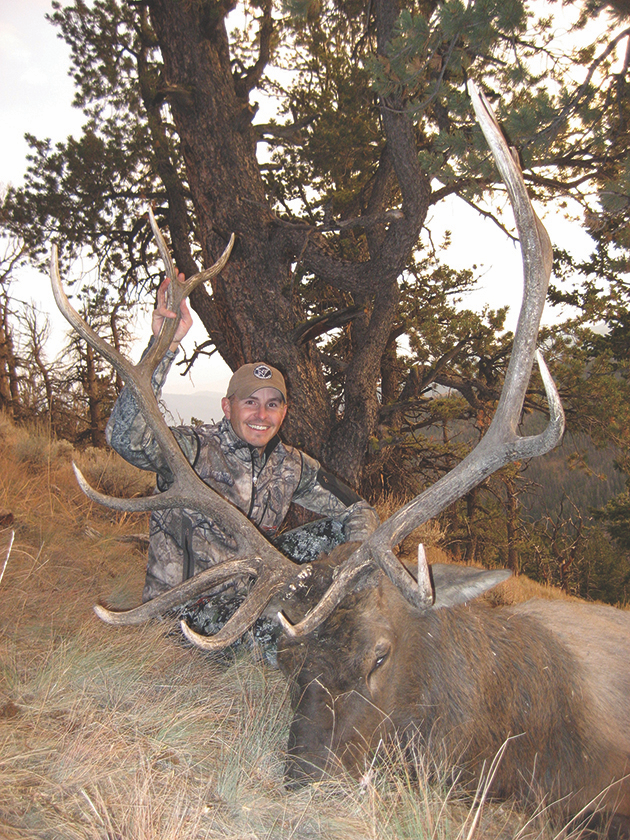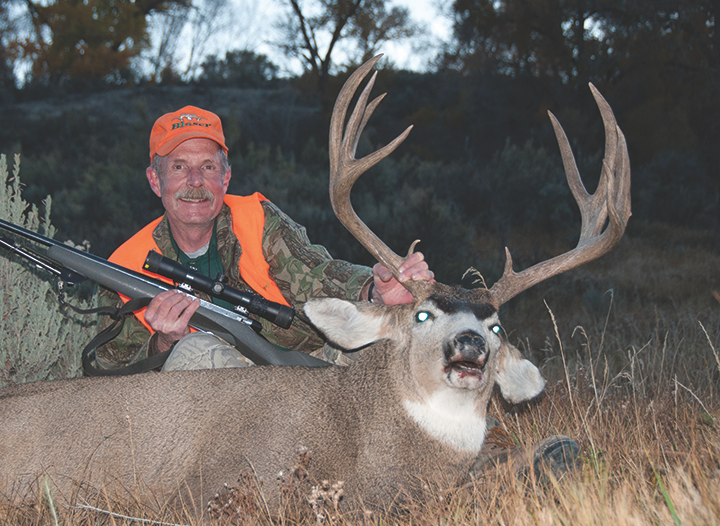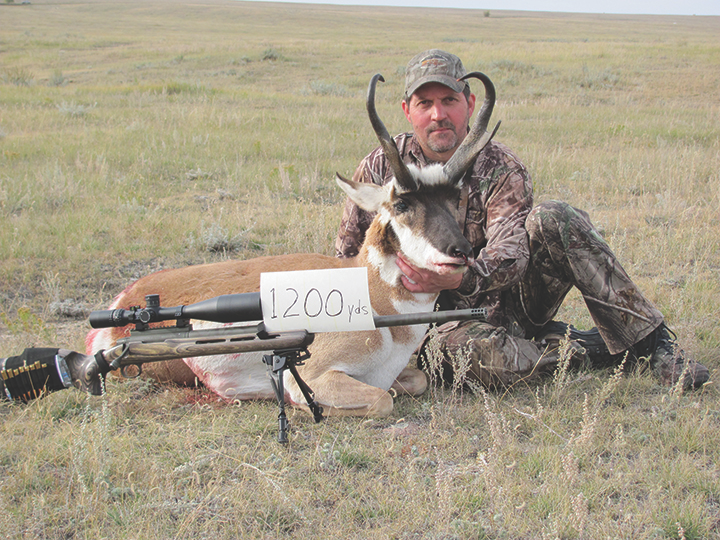We gulped the last of our coffee, the only warmth to be had in the pre-dawn blackness, the time when the mountain chill cuts with a knife’s edge. Soon, Jerry and I would each head to our chosen spots, brimming with the anticipation and confidence opening morning brings.
“So,” Jerry asked, the concern on his face revealed by the dying campfire, “just how far is too far?”
It was a profound question, laden with implication. Jerry is a good and conscientious hunter, but had not had a lot of experience shooting at the distances we might encounter in the vast, open country where we would spend the next several days.
Jerry knew that my job had, over the last several years, required exploring and learning about the technology, the tools and the techniques of shooting at long distances. I respected him for asking the question. Too many hunters seem to believe that all men are born with the shooting skills of a Special Forces sniper, and to admit a lack of prowess in that area somehow equates with questionable manhood.
Nightforce Materials Manager Mark Cochran takes an exceptional bull elk almost every year in the Idaho mountain wilderness, often at distances between 500 and 1000 yards.Mark’s secret? First, a willingness to pack in by himself for miles, distancing himself from other hunters. Second, using good optics and being thoroughly familiar with his rifle’s performance at every range. His success is a result of hard work and thorough preparation, not luck.
I had made that admission a number of years ago (regarding my shooting ability, not the manhood thing), and it was a painful, but essential, first step to becoming a better hunter. Out to 250 yards or so, I was a pretty good shot. Beyond that, I had to confess, I was guessing. For me, “too far” was “not as far as I’d like it to be.” In those days, hunting at extended ranges was a new and exciting subject; one that I knew held a number of technical challenges. What I didn’t know was how many personal challenges it held, as well.
I have always believed that one of the greatest indicators of intelligence is to admit what one doesn’t know. Saying those words, though, sticks in the throat of many people (especially politicians, but that is a different subject). “I don’t know” is a wonderful statement. It leads to exploration, learning, knowledge, new experiences, and wisdom. Sadly, many individuals find that saying those three words is somehow a confession of stupidity, of ignorance, of being dull-witted. The media is full of “experts” who claim to know all, as if they were blessed with omnipotent powers we mortals will never enjoy.
The sad thing is that ordinary mortals like me tend to read such dissertations and instantly assume we are experts, too — not because of hands-on experience, or through verification with our own eyes, but simply because we read it somewhere.
“How is your rifle sighted in?” I asked Jerry.
“Oh, it’s three inches high at 100 yards,” he answered confidently, expecting me to nod in agreement.
“Why?” I asked.
“Well, er,” he stammered, “I’ve always read that if you do that you’re good for anything out to 300 yards or more.”
“That may very well be,” I replied, “but have you ever tested that theory? Have you shot at 200, 300, 400 yards or more? With a consistent load? We’re over 9000 feet in elevation here. Do you know how trajectory varies at elevation versus sea level?
“What happens if you by chance have a very close shot — say 30 yards — you may have a good idea of your trajectory beyond 100 yards, but how about up close? Do you know how high your bullet might be above your line of sight at that range?”
“And what about wind? Adjusting for elevation is easy. But how do you adjust for the wind we always get here?” I said, motioning to the tops of the pines already beginning to sway in the morning upslope breezes. “I know you’ve spent time with ballistics tables that focus on elevation. But have you studied the effect a ten-mile-per-hour crosswind has on your bullet? What if it’s blowing at thirty?”
I was not trying to be condescending. I was thinking back to my first attempts at learning to shoot effectively at long ranges, and how quickly it became obvious that I had a long, long way to go.
No, I was trying to impress upon Jerry the gravity and the difficulty of attempting to take an animal’s life at several hundred yards…and most of all, to encourage him to give serious thought to all the factors influencing his shot before pulling the trigger, not afterwards when it is too late to correct.
* * *
Few topics in the shooting industry have raised more interest — and more hackles — than long-range hunting. Turn on the television, and you’ll see skilled shooters taking big game at 800, 900, even 1000 yards and beyond. For every advocate of extreme-range hunting, you’ll find another who decries the practice as unethical. So who is right? Turns out, they both are. I turned to some acknowledged experts in long-range shooting for input based on fact, not opinion.
The author threaded a shot through a narrow opening in thick oak brush to drop this fine mule deer with one shot at 267 yards. “That distance doesn’t qualify as ‘long range,’ he said, “but there were only a few inches of the buck’s vital area visible. I was using a Nightforce scope with a Velocity reticle matched to my rifle’s ballistics, so I knew exactly where to hold at that distance to place the shot. It proves that the need for precision shooting is not always a matter of extreme distance.”
“So, how far is too far?” I asked Sean Murphy, director of marketing communications for Nightforce Optics, Inc. “If someone doesn’t know their rifle and doesn’t shoot much, any distance can be too far,” said Murphy. “At the other extreme, highly accomplished shooters are pushing the long-range envelope ever further. Today, 1000 yards is old hat. Shooting with extreme precision well beyond a mile is not only feasible, but it is being done every day.”
Nightforce made its reputation based on the extended-range capability and superb quality of its products. Indeed, more competitions have been won and long-range records set with Nightforce riflescopes than any other brand. One might think that a company like Nightforce would be a highly vocal advocate of long-range hunting, but they are remarkably reserved on the subject.
“If you watch some of the long-range hunters we partner with,” Murphy said, “you’ll see what makes an accomplished shooter. Obviously, good optics are essential. But, they fire thousands of rounds a year, constantly experimenting with the best bullets and optimum loads for their rifles. They understand what happens downrange, both through the use of sophisticated software and years of applied experience. Above all, it is practice, practice, and more practice. They shoot more rounds in a few months than the average hunter will shoot in a lifetime.”
“But,” I asked Murphy, “What about that emotionally charged word, ‘ethics’?”
“Hunters have been trying to extend their range ever since firearms were invented,” Murphy answered. “It is, for better or worse, human nature. Most of us who hunt have witnessed the sad spectacle of one or more ‘shooters’ — I won’t call them ‘hunters’ — lobbing round after round at a game animal hundreds of yards away, with no idea of the actual distance or their rifle’s ballistics, hoping to hit the poor creature somewhere — anywhere. Unethical? It’s worse than that. It’s inhumane.”
“The tools and technology exist to allow today’s hunter to shoot with more precision and confidence at greater distances than ever before,” Murphy continued. “That’s what we make at Nightforce. But, just as buying a pair of Air Jordans will not instantly make you a NBA star, or buying a camera doesn’t make you an accomplished photographer, merely purchasing the equipment or falling for the latest ‘long range’ marketing gimmick will not make you a world-class shooter. It takes many days at the range, an in-depth understanding of your rifle’s capabilities as well as your own, and a whole lot of shooting in every conceivable environment. When you pull the trigger on a game animal, you want to know where that bullet will hit…not hope.
“Ethics, you either have or you don’t. Skill is something you can acquire.”
Leo Anderson took this pronghorn at 1200 yards using a Nightforce NXS 5.5-22 x 56 riflescope. Leo is also a professional competition shooter, with dozens of long-range titles to his credit. For a shooter like Leo, there is no guesswork involved in making a shot like this, and “how far is too far” means something far different to him than to the average hunter.
* * *
NEXT IN PART TWO, the author admits to massive failure in his first long-range shooting attempt, and we’ll explore some of the tools that make long-range hunting feasible…with caveats. Will Jerry get his answer?
About the Author:
Tom Bulloch has worked in the optics industry for over 21 years. He has hunted on six continents, doing, as he puts it, “more hunting for less money than any man alive.”
His credentials as a mountain hunter include two ibex, bighorn and Dall sheep, a mountain goat, tahr, chamois, mouflon, and many timberline elk and mule deer. He lives at nearly 9000 feet in the Colorado Rockies, where, he says, “even looking for my car keys is a mountain hunt.”




